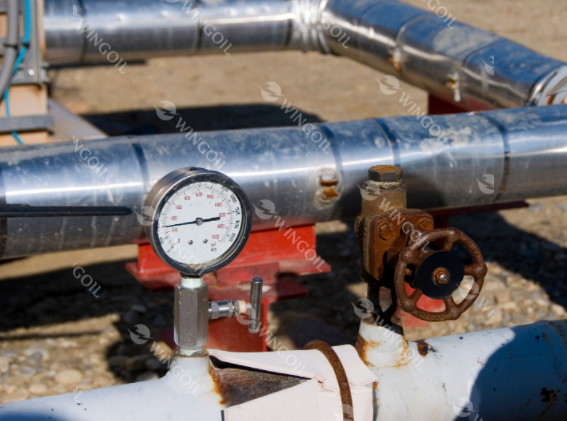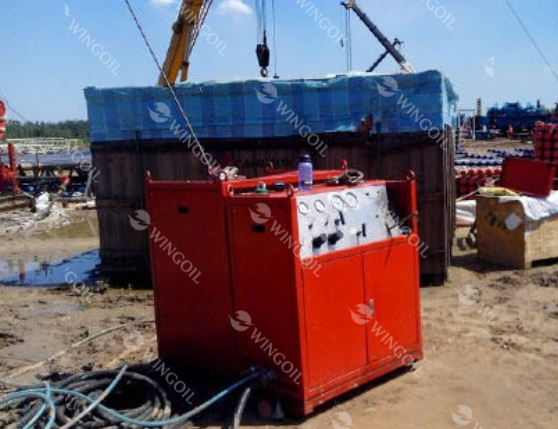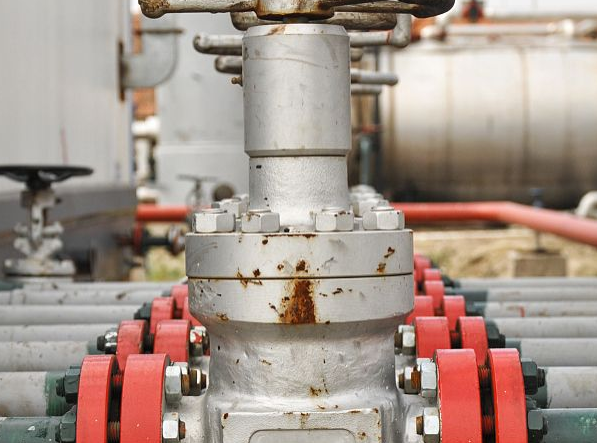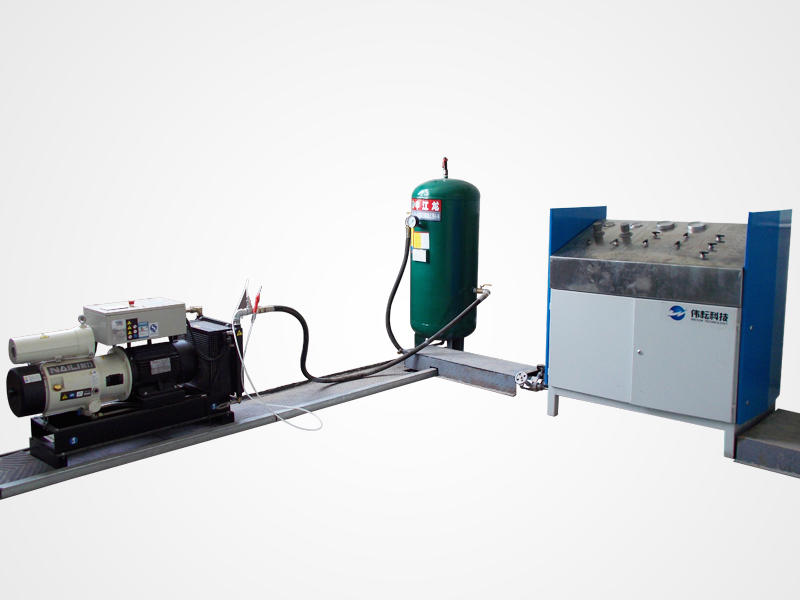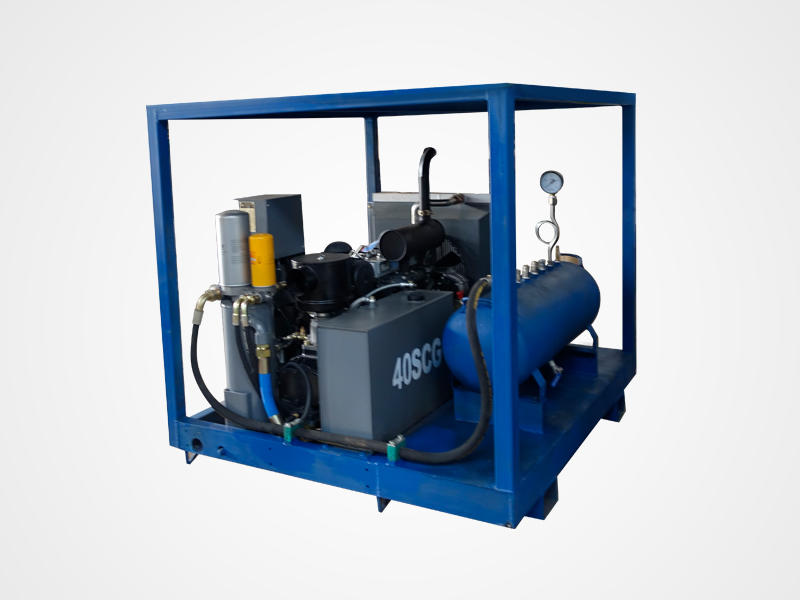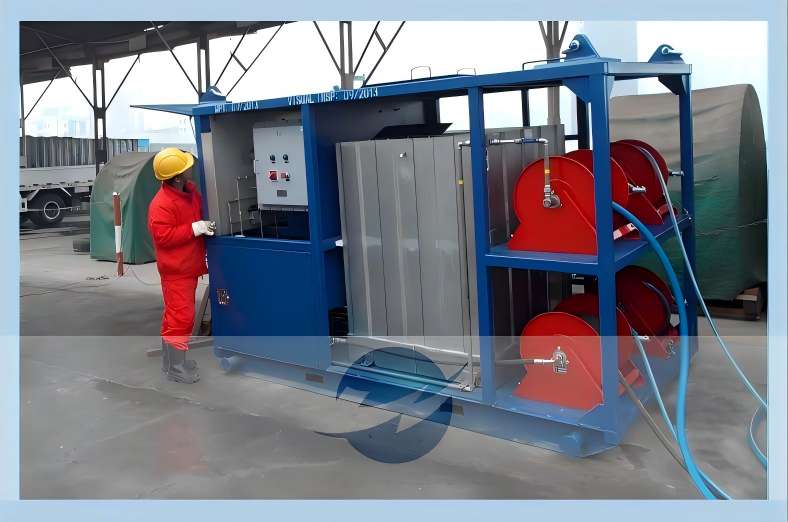Chemical Injection Package: Everything You Need to Know for Industrial Use
Precise chemical dosing is indispensable for the protection of equipment, stability of processes, and efficiency in the oil & gas, chemical, and water treatment industries. Chemical injection package, being an integrated and controllable chemical dosing system, has become a vital piece in modern industrial operations.
In this post, we will offer comprehensive insight into chemical injection packages with respect to definition, structural components, working principle, type, application, and key factors for selection; thus, helping businesses understand and choose the right dosing system for their needs.
Part 1. What is a Chemical Injection Package?
A chemical injection package is one integrated system devised to inject into industrial processes corrosion inhibitors, scale inhibitors, defoamers, biocides, and demulsifiers with precision in both flow and pressure.
Its core value is to guarantee stable, controllable, and accurate chemical dosing, which prolongs equipment life, improves production efficiency, and cuts down on maintenance costs.
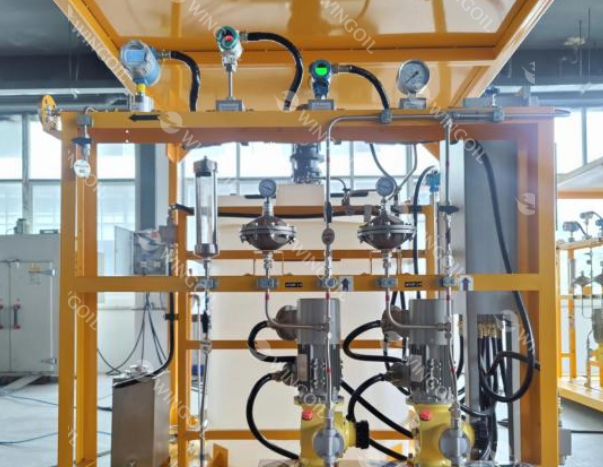
Part 2. Why are Chemical Injection Packages Essential to Industrial Systems?
Real-world industrial operations demonstrate how chemical dosing has an enormous effect on system safety, operational stability and overall production efficiency. Poor chemical dosing could leave systems vulnerable to corrosion, scaling, microbial growth or fluid instability; an injection package helps ensure accurate doses are given at appropriate times under specific conditions – helping ensure system health.
Key reasons for its importance include:
- Corrosion Prevention: Injecting corrosion inhibitors into the system offers protection from degradation effects caused by corrosive fluids on pipelines, valves, pumps, pressure vessels, and other critical components.
- Scale Control: Proper injection of scale inhibitors reduces mineral scaling, keeps the internal piping area flowing smoothly, and reduces pressure drops and energy consumption accordingly.
- Improved Recovery of Oil & Gas: It contains chemicals like demulsifiers, defoamers that enhance the separation efficiency by minimizing foaming to optimize oil, gas, and water handling processes.
- Stable Water and Fluid Quality: It ensures stable water properties through the use of biocides, pH adjusters, and other water treatment chemicals to prevent microbial or chemical contamination.
- Reduced Equipment Damage and Downtime: Precise chemical dosing can help minimize premature wearing of equipment, unexpected failures, and expensive production interruptions.
A chemical injection package provides metered, automated, continuous, or scheduled dosing to maintain constant process conditions and minimize the chances of human error. This makes it a very important element in achieving refined, stable, and efficient industrial operation.
Part 3. Main Components of a Chemical Injection Package
A standard chemical injection package is generally designed with the following key components, which assure precision, safety, and stability in chemical dosing:
1. Injection Pump / Dosing Pump
The pump is the heart of the injection system. Common types include plunger pumps and diaphragm pumps, either will be specified based on the chemical compatibility and pressure requirements.
- Provides chemicals with accurate flow rates and pressures
- Supports both high-pressure and low-pressure injection applications
- Can be configured for continuous, intermittent, or batch dosing
- Often includes stroke adjustment or VFD control to ensure accuracy
2. Chemical Storage Tank
The storage tank holds the chemicals that are to be injected and is available in a variety of materials like carbon steel, stainless steel, PE, and FRP, depending on the properties of the chemical.
Features usually include:
- Anti-corrosion linings or coatings
- Level switches or level transmitters
- Venting, manholes, and mixing devices, where necessary
- Safe containment to prevent spillages

3. Piping & Valve System
This system transports the chemicals from the tank to the injection point and typically includes:
- Process piping
- Isolation valves
- Safety relief valves
- Check valves to prevent backflow
- Pressure-rated fittings and joints
This design ensures safe, leak-free, and reliable chemical delivery.
4. Instrumentation
Instrumentation provides for real-time monitoring and protection of the system. Common devices include:
- Pressure gauges and pressure transmitters
- Flow meters for verifying actual dosing flow
- Level indicators or smart level sensors
- Temperature monitoring instruments
These instruments help maintain accuracy, safety, and process visibility.
5. Control System (Control Panel)
The control system operates and automates dosing operations. Depending on the given project, it can support:
- Manual operation
- Automatic control
- PLC-based intelligent control
- Timed or batch injection
- Alarm functions for low level, overpressure, pump failure etc.
Advanced PLC systems may integrate with SCADA or DCS for remote monitoring.

6. Skid-Mounted Frame
The whole system is mounted on a steel skid which may be:
- Open-frame for easy access and maintenance
- Enclosed or cabinet-type – for harsh or hazardous environments
Skid design ensures:
- Facile transportation and installation
- Structural stability
- Compact integration of all components
7. Flushing System and Eyewash Station (Optional)
Some chemical injection packages come with chemical flushing and an eyewash station to increase on-site safety.
The flushing system enables operators to wash the piping, pumps, or points of injection post-chemical dosing to avoid residue accumulation that could make maintenance unsafe.
An eyewash station is intended for providing immediate emergency rinsing to personnel accidentally exposed to chemicals and thus to increase general workplace safety.
Part 4. Working Principle of a Chemical Injection Package
The general steps in the operational workflow of a chemical injection package are:
Chemical Storage: The solution required is kept in a specific storage tank with provision for monitoring the level and anti-corrosion protection to store it safely.
Chemical Suction by the Dosing Pump: The injection pump draws the chemical from the tank based on pre-set flow and pressure requirements. Pump operation may be adjusted through stroke control, frequency control, or PLC commands.
Pressure and Flow Stabilization: The system uses valves and instrumentation to regulate the pressure, ensuring a stable and accurate flow even in changing process conditions.
Injection into the Target System: The chemicals are conveyed through a piping system and injected directly into pipelines, wells, vessels, or processing equipment at strategically positioned injection points.
Real-Time Monitoring and Automatic Control: The control panel constantly monitors pressure, flow, and tank level to achieve dosing that is appropriately timed, metered, or continuous as the process requires.
Safety Protection and Alarm Functions: The system can provide overpressure protection, low-level alarms, and alarms on pump faults along with automatic shutdown mechanisms for safe operation.
This workflow grants accurate, effective, and reliable chemical dosing to ensure stable and safe operation of the whole industrial process.
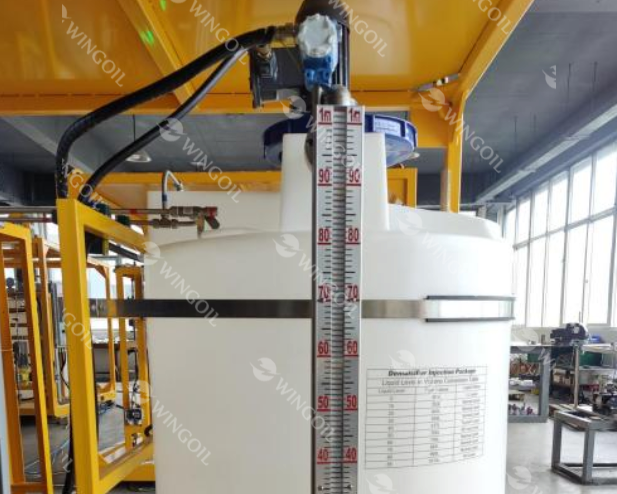
Part 5. Industrial Applications of a Chemical Injection Package
Chemical injection packages find broad applications in many different industries wherein accurate dosing of chemicals is literally critical to process efficiency, safety, and equipment longevity.
Typical applications include:
Oil Extraction and Water Injection Systems: Used to inject corrosion inhibitors, scale inhibitors, and biocides that protect wells, pipelines, and injection equipment.
Pipeline Corrosion Protection: Ensures the long-term integrity of pipelines used to transport oil, gas, and chemicals through continuous or periodic chemical dosing.
Demulsifier Injection in Refineries: It enhances oil, water, and gas separation, thus optimizing refinery operations and product quality.
Industrial Cooling and Circulating Water Treatment: Their main application is to maintain water quality, preventing fouling in cooling towers, heat exchangers, and other systems.
Boiler Water Treatment: Maintains appropriate pH, prevents scaling, and reduces corrosion in high-temperature boiler systems.
Gas and Natural Gas Transmission: Protects pipelines and equipment from corrosion and scaling when transporting gas over long distances.
Offshore Platform Oil-Water Separation Systems: Chemical dosing assures efficient separation and reduced foaming while preventing microbial contamination in seawater and produced water systems.

Part 6. Key Considerations for Selecting a Chemical Injection Package
When selecting a chemical injection package, the following are some critical factors that companies should seek to ensure optimum performance, safety, and life:
Injection Pressure and Flow Requirements: Determine the chemical flow rate that needs to be provided and injection pressure to realize process conditions for accurate dosing.
Pump Type Selection: Choose between plunger pumps and diaphragm pumps based on pressure, chemical compatibility, and maintenance requirements.
Chemical Types and Compatibility: Ensure all wetted parts are compatible with the chemicals in use, including corrosive or viscous fluids.
Material of Contact Components: Usual materials used in such cases are SS316L, duplex stainless steel, PE, or FRP, depending on the chemical properties and environment.
Multi-Point Injection Needs: Consider supporting multiple injection points within the system in case of complex process setups.
Automation and Control Requirements: Choose between manual, automatic, and PLC-controlled dosing, including timed, continuous, or batch injection, depending on the complexity of the process.
Power Supply Requirements: Confirm the available power options: AC, DC, or even solar-powered systems that ensure reliability in operation.
Explosion-Proof and Safety Ratings: Consider ATEX or IECEx certified systems for hazardous environments to meet safety legislations.
Installation Environment: Consider if the package will be operating outdoors, offshore, or under extreme conditions; specify the enclosure accordingly, as well as the skid design with associated protection features.
Proper selection of a chemical injection package will significantly reduce maintenance costs, enhance process efficiency, and ensure stable and safe operation of industrial systems.
Part 7. Why Choose Wingoil Chemical Injection Package?
The chemical injection package of Wingoil offers an open skid-mounted integrated design solution in which liquid storage, pump & piping system, and electrical control are combined into one compact entity. Safe, dependable, and accurate, this chemical injection fully meets the various demands of oil & gas, chemicals, water treatments, and many other industries.
This system operates both manually and automatically, according to the schedule. The standby pumps and pipeline energy storage devices assure continuous and stable operation.
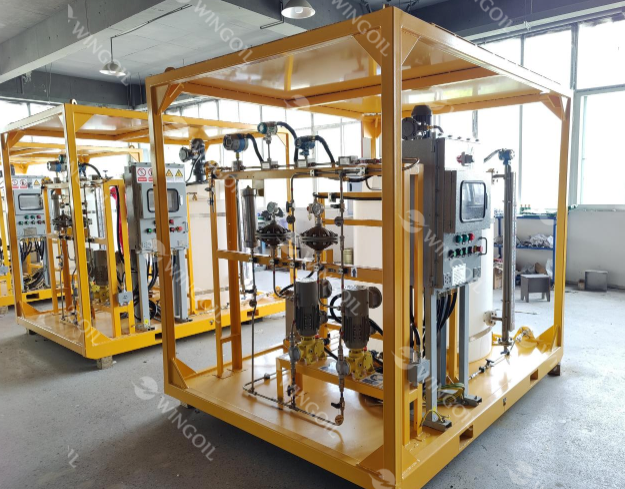
Key Features
Integrated Three-system Design: liquid storage, pump & piping, and electrical control systems are integrated into a single skid that can be tailored for most project applications.
High Reliability: The mechanical diaphragm dosing pumps are one-in-use and one-standby; the energy storage devices are also configured in a one-in-use, one-standby setup for the pipeline. All pipelines are 316 stainless steel. The fluid connections are by ferrule fittings to ensure stability of the system and resistance against corrosion.
Convenient Maintenance & Safety: Open skid design allows for easy maintenance, a 20mm sump at the bottom prevents chemical leakage, and a sunshade on top protects equipment from direct sunlight and rain.
Precise Control & Automation: Flow can be infinitely adjusted within a 0–100% range, with precise control between 10–100%. The panel allows scheduled tasks, real-time fault codes, and alarm buzzers to be triggered for system safety.
Remote Integration Capability: An external PLC module is reserved inside the package for connection to the main control system, allowing remote monitoring and data management.
Wingoil chemical injection package assures reliability, safety, precision, and efficiency in chemical injection, serving a wide range of industrial applications in the oil & gas, chemical, and water treatment industries.
In Summary
The chemical injection package is important equipment, the accuracy and stability of which determine the chemical dosing to industrial processes. If appropriately selected, robustly designed, and professionally manufactured, corrosion risks can be greatly minimized and heavy industries may save on downtimes, improving overall production efficiency. If you need a reliable chemical injection package, you can rely on Wingoil!

